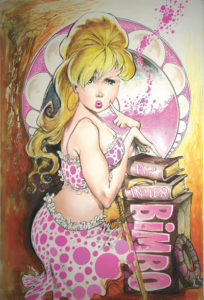
Welcome back for part two of my interview with Sam Kieth [part 1]. Those who are familiar with Sam’s stories have probably noticed a consistent theme of injured or dead pets/animals within his books. Even those who are solely familiar with The Maxx comics or animation will probably recall the little injured rabbit under Julie’s bed. In this portion of the interview, I speak with Sam about his former pets and how they have impacted his methods of story-telling. Also, we talk about the status of the Four Women film and Sam’s personal inner bimbo.
Comic Attack: I heard you speak of your inner bimbo before the Inner Bimbo comics were published. How far back does this concept predate the books?
Sam Kieth: The bimbo…the story was in my head for about ten years before I drew it. I probably did about four or five different versions of the first issue. I would get about fifteen or twenty pages done and destroy the whole thing. I finally said, ya know, if I do this book again, I really want it to be around and not destroy it (laughs)…or make a photocopy of the pages and then destroy it. It turned into a very tedious project. I don’t know. It seems like everybody has different parts of themselves. I thought about releasing a book that just basically divided myself into twelve archetypes. Because everybody has a tough side…a sensitive side…and the point of the book was not so much about gender, than a guy who saw himself as vulnerable, but because of whatever limitations in his head, he first had to find that feminine side. Then, when he was older and more secure, he had to reduce that to a bimbo. It could have been a male bimbo. But being a man – a misogynist – he decided to make it a female bimbo. The essence of the story was not about a guy that’s a cross-dresser or has gender issues. It’s really about a guy that needed to look at himself, and because he couldn’t face that he was this under-age person that didn’t have a lot of power in society. He had to turn himself into a trivial woman, and that woman kept growing as he remembered himself growing into certain changes. So, later, he felt like a rebellious person that the bimbo becomes. Then, finally, somebody who grew up and was able to take care of his life, and was just wearing normal clothes like everybody does.

CA: In The Maxx there was a story line that involved an injured rabbit. In Batman: Secrets there’s a duck that’s been shot. Then, in Ojo, you had the numerous pets that died. Was there an experience with a loss of a pet that created this theme in your writing?
SK: (deep breath) Wow! You do read my stuff don’t you! You can always tell when somebody says, I like your stuff, and then they actually go through this body of work and tie things together and you go, yeah, you’re right, I never did think about that before or, ya know…it’s just uh…(Sam digresses)…but anyway, getting back to that. I’m trying to think if I’ve talked about this. I don’t think I have. I imagine you’ve read most of the stuff I’ve been interviewed about.
CA: I have, but I don’t recall reading anything about this particular theme in your stories.
SK: About pets. Yeah. In Ojo, there was the little girl that killed three pets before the first three pages or something. In essence, I had…what did I have?…I had a snake, but it wound up getting killed. I just got tired of watching it eating mice. I did have a Chinese water dragon that I got when I was in my twenties. It broke its jaw. So we finally had to put it out of its misery.
CA: What happened?
SK: Actually, they have these little jaws. On the right side of the jaw, there’s this thin piece of bone, and that piece broke. So, it wasn’t able to chew any of the crickets that I fed it. It was too painful for it to eat. Well, the vet said it was gonna starve to death, and the most humane thing to do is to inject it with something and put it in the freezer. After that I was pretty much done with reptiles as pets.

CA: Did you put it down yourself or did the vet do it?
SK: (voice drops) I just decided to do it myself. Of course, I probably should have had the vet do it, but he said, look, do it yourself, and so, I did it. I did a story in IbeforeE about a kid who had a pocket full of frogs. That was because I would take these little frogs to school and zip them up in a zipper pocket. I didn’t realize it, but my mom washed them in the laundry. She unzipped the pocket and saw all this gooey stuff, and said, what is this?!…and I said, I don’t know, and then I thought, OH NOOO! That was me…my frogs. My wife has had experiences with pets growing up. Both of us are always working on the guilt issue…and the pet issue…and the moral responsibility issue. It also may be because we don’t have kids. We’re one of those really sad childless couples that injects all that weird energy into pets and pretend like they’re kids.
CA: You were raised by a single mother, right?
SK: Pretty much yeah.
CA: I think that when you’re in that type of environment, it’s easy to project those types of emotions onto pets.
SK: Yeah, you’re a little more vulnerable, and when you’re a man, it’s kind of your first chance to take care of something, ya know…have empathy with something. Yeah, that plays throughout the books…dead pets and dysfunctional relationships. You know, I’m amazed. There are very few people that have asked me this, but I always thought the most interesting thing to me about the Batman: Secrets mini-series with The Joker wasn’t all the fights with Batman and The Joker…or even the conversation they had in the dark at the end when Joker’s in a straight jacket and they’re waiting for him to be picked up. It was the really bizarre relationship he had with the district attorney, and the fact that he has this idea that he should beat himself up, but he should beat her up, too. Which is a pretty sick idea obviously, but I was pretty interested in why somebody would… I mean it would make sense for The Joker to do something that horrific…but I’m fascinated by women who are drawn to people that hurt them and eventually wake up and stop that.

CA: You know what I took from Batman: Secrets more than anything?
SK: What?
CA: The conversation at the end of the book where The Joker was trying to get this secret out of Batman. Batman gives him the secret and The Joker’s really disappointed by it. It spoke to me personally, because you hold on to these small things that aren’t a big deal to anyone else, but you build them up in your own mind to a degree that it just tears you apart.
SK: Exactly.
CA: Once The Joker finds out, he’s like, that’s nothing, but Batman’s fist is clinched and this secret has obviously tormented him.
SK: That’s exactly it. I think you verbalized it more than I did when I was writing it, but one of the dilemmas about this is you can’t really do a story about Batman clutching his dead mother. People have shown you that. I wanted to see how much we could do something just to the left of that. In other words, when he told him the secret, it almost seems to represent an ugly memory he can’t directly go to. Certainly not in a conversation with The Joker. Then, there’s also the idea of the raindrops playing off of them as pearls in the original. It gets tricky when you’re dealing with these things, and I almost feel like, well, I don’t wanna be messing with that. Like Nolan’s version of that universe. People are saying, yeah, that’s the theme of Batman. Everybody comes in and puts their stamp on it, and does what they have to do. One of the problems with me doing these superhero books is that I tend to do stories from the inside-out. I write about things that are usually more modern stories and have to do with emotional pain rather than characters fighting on a rooftop and a lot of physical jeopardy.
CA: But that’s what I expect. I pick up your books to read that perspective of the superhero universe.

SK: You do, but then there’s other people that scratch their head, trying to get through that to get to somebody punching somebody else in the face…or somebody saying some dramatic lines like, “it’s what I do, I kill people.” You know, any of the cliches we already have in comics. I’m telling you, I borrow against everyone’s patience. Jim McLauchlin from the ‘Hero Initiative’ called me up and said, I read Arkham Asylum, and it’s The joker and all these cells, but it’s actually a story about somebody who really hates their job. It’s this nice nurse that has this crappy job in the asylum. He said, I just want her to get out of this terrible job. I said, well if she had gotten out and everything was fine, it wouldn’t be a horror story. But my version of a horror story is she still stays, even though she could leave. He said, but yeah, that just drives me nuts! She should have left. I said, I know…I know.
CA: I felt that way when I was reading Four Women. I was like, why don’t they just get out of the car and do something!?
SK: Plot-wise, that would make the most sense…that they would rush these guys. It’s also a stretch plot-wise that she would lock her best friend out to save the other woman. It’s one of those stories that the greatest theme is, would you betray your friend to save a couple of extra people, but you have to make believe she felt it was necessary to lock her friend out. Which is a pretty big leap, and it could be argued that it’s where the story falls apart.
CA: It’s easy to look at it from the outside and say, do something! On the other hand, I have no idea what it’s like to be in that situation or how I would react in those circumstances.
SK: It’s true. A guy actually did pull a knife on my wife. He opened the door, and he pulled a knife. It scared the hell out of me and her, but luckily she was OK. He ran off. When she was in the car, she looked out the window and saw another woman in a car nearby. Which terrified her, because she was looking at this guy holding a knife to my wife. I said to my wife, why didn’t she honk the horn?…why didn’t she jump out and run over there? Do you blame her for that? My wife said, no, I would have stayed in my car, too! I said, really? What if it was your friend? Well, I guess I can’t tell you for sure. What if your friend was right next to you? What if your friend had to lock you out? She said, well, you have to give me specifics. That’s such a generic series of things. So, that’s kind of where the story came from…ya know, how far would you go? It was really interesting when we were working on the Four Women movie. We had the money and the actresses in place to go through the script…to go through all these questions about it. Now, there’s a whole new set of producers and people interested in it, but I have to tell ya, it’s probably the last movie I wanna make because it’s such an unpleasant subject. I can draw it, but when the actors are doing it… It’s like, of all the subjects you’d like to do in a movie, would you like to make a really gritty ugly experience of cruelty and rape? ..and now, would you like to enact it with real people and shoot that for two or three weeks? There’s probably like a hundred other stories I’d rather do (laughs)! Believe me, I got sick of The Maxx when we did the comic. There was an audio soundtrack, and by the time we actually did the animated cartoon, I thought, I can go the rest of my life with never hearing somebody say, “it’s dark and wet” and talk about Cheers being on. Because you hear it so many times! I thought, I could never sit through making a live action Maxx movie. First of all, I’d have to get rid of the Cheers line because nobody knows what that is anymore. Nobody remembers it, but thank goodness we got it out, ’cause today it would be a totally different animal. But man, you go through these versions of things in production where you live with it forever!

CA: As of now, what’s the status of the Four Women movie?
SK: It’s sitting on a big pile of things to do. People involved have said, “when you’re ready to write a script that you’re happy with, we’d like to move forward,” and I said, how bout a half a dozen other things that are a lot more cheery than that. I’ll even take one of my dysfunctional lesbian mother/daughter relationships. Because that kind of thing I can get into! But, ya know, it’s just a really…um…(small frustrated sigh) I don’t even know if I know who wrote that story anymore. You know what I mean? I’m not even that guy anymore.
CA: Four Women was a fast read because there was so much tension. The only thing I can compare it to cinamatically would be the Last House on the Left (2009). I truly believe that Four Women would make a great film.
SK: Well, and there’s also…even some of the better thrillers like Silence of the Lambs, they have this really horrifying aspect, but then there’s a certain amount of emotional catharsis and consequence to them. They actually develop characters that are real. Then, if you have a horrifying situation that somebody has to fight or do something they believe in, you get the best of both worlds. The problem is, it’s not really a Sam Kieth story. Usually my stories deal with dark gritty issues, but they almost always have some sort of surreal, magical, or quirky element to them. With Four Women, I was trying to prove I could tell a normal story that was gritty, but I almost feel like anybody could make that movie now. You know what I mean? All they would have to do is follow the material. Which of course they never do in Hollywood, but they’d have to follow that material. Actually, when I went through it with a friend of mine, I asked a freind of mine, Andrew Friedman, to go over the script, and I said, tell me what you don’t buy. Tell me twelve points you don’t buy in this movie. He went through, and I thought, OK, this is it. I could re-write the script from this outline and it satisfies everything I need. It’s just that I have nineteen other stories that I’d rather tell first.
CA: You know what I think’s funny, Sam?
SK: What?
CA: The fact that Four Women is your idea of telling a “normal” story.
SK: (laughs) Even that doesn’t qualify? Yeah, you’re probably right, but in my mind it seems like Sam Kieth’s version of a normal story. You could hand it to the Cohen Brothers and they would wind up making it their own quirky world. Even when they tell a normal story, it’s still unusual. Some people would say, No Country For Old Men, that’s a pretty straight forward story, but it’s still unusual.
CA: It has their imprint.
SK: Exactly. There’s a lot of writers that can write great stories. Then there’s some writers/artists/directors that are unapologetically quirky.
Click here for part three of this multi-part installment of Artist of the Month for more of my conversation with Sam.
Bonus: 30 Days of Night, Again cover gallery:
Josh Jones
josh@comicattack.net

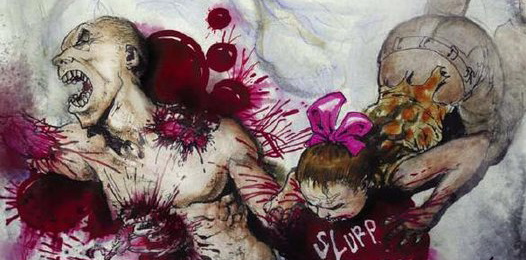
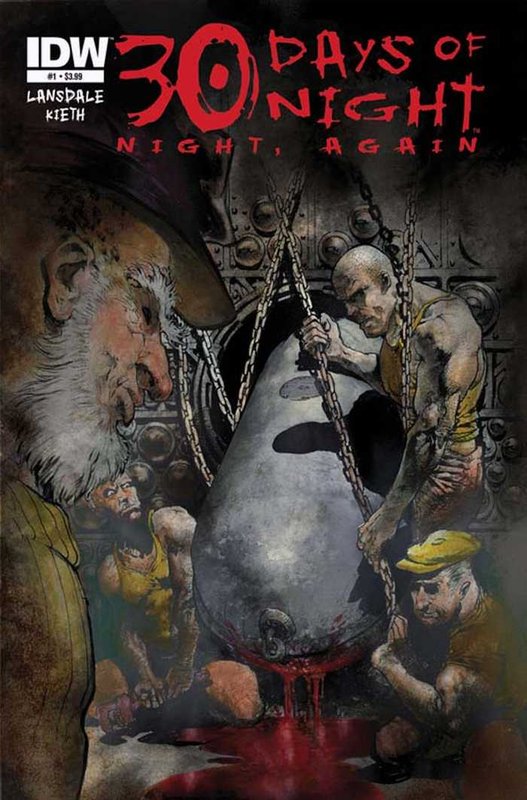
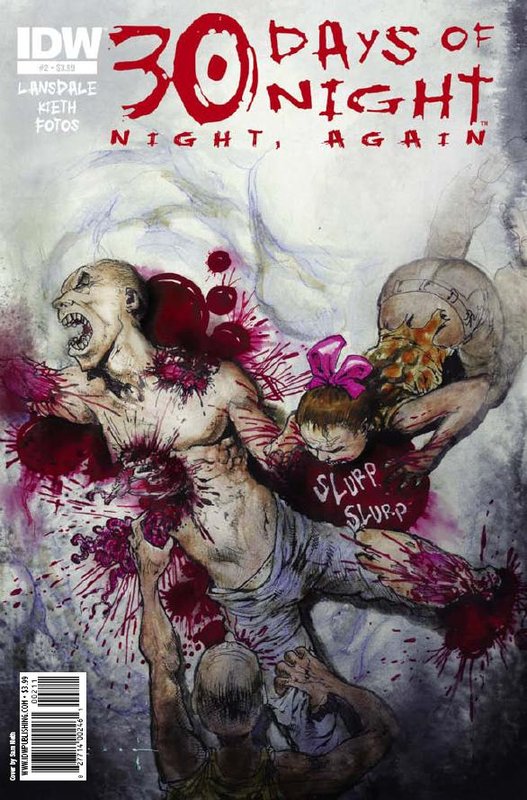


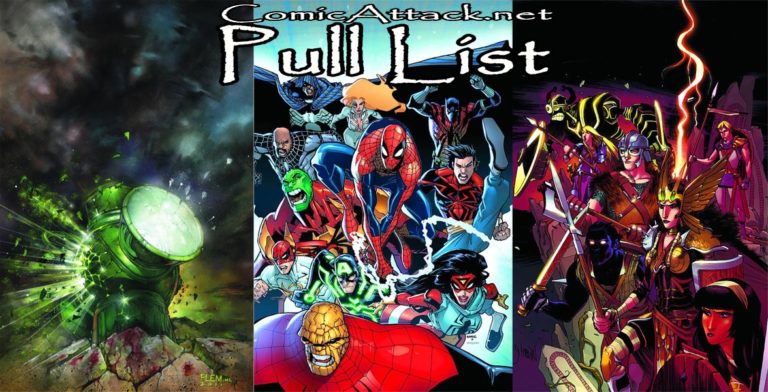
Thank you so much for doing those interviews with Sam Kieth, they are trully awesome, the man is a genius and I would buy anything by him, his layouts are fantastic, glad to see his output lately being steady.
I am loving this. Sam Kieth is my favorite artist and for a while it was so hard to find out any news about what he was doing, now he’s got the blog, and he did this interview which is getting more in depth about the work he’s already done, i can never get enough Sam!
It’s nice to hear from Mr. Kieth. I hope he keeps going for a long time.
Thanks for doing your research and asking him good questions.
Pingback: Artist of the Month: Sam Kieth Part 1
Pingback: Artist of the Month: Sam Kieth Part 3